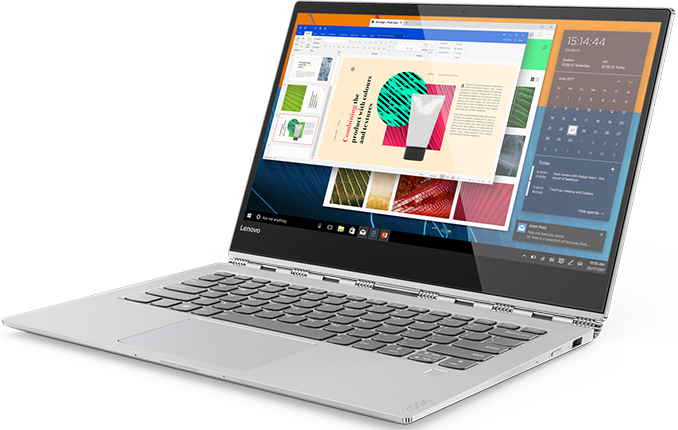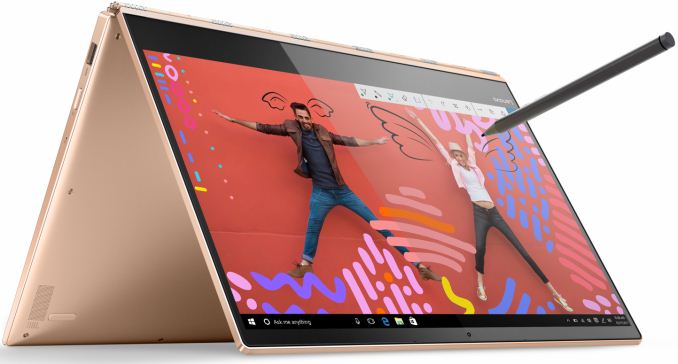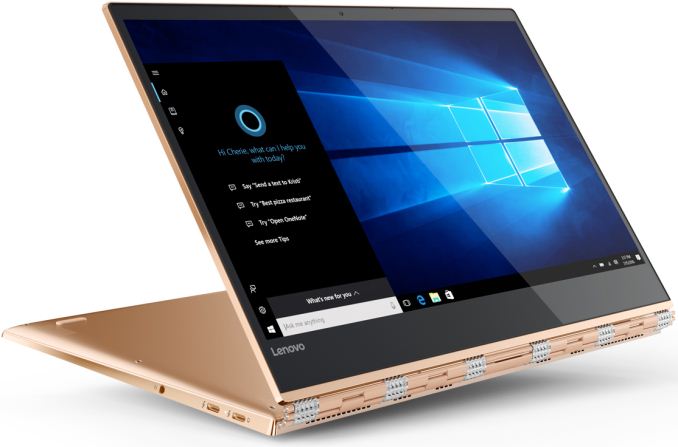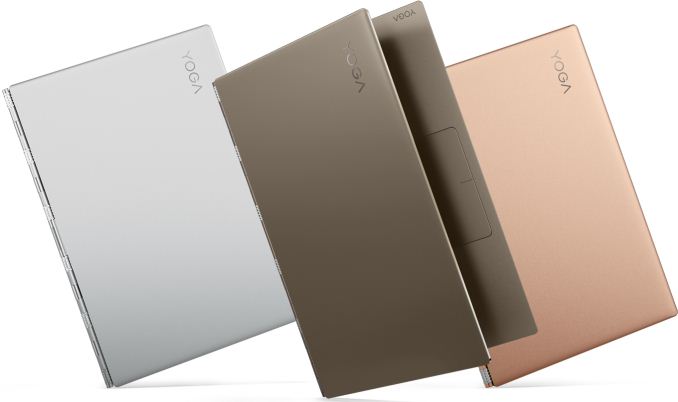Lenovo Launches Yoga 920 Convertible: 13.9” 4K LCD, 8th Gen Core i7, TB3, 3 Pounds
by Anton Shilov on September 2, 2017 3:00 PM EST
Lenovo this week announced its new Yoga 920 convertible laptop that became more powerful due to Intel’s upcoming 8th generation Core i-series CPUs with up to four cores, better connected thanks to two Thunderbolt 3 ports, yet slimmer than its predecessor. The new model inherits most of the peculiarities of the previous-generation Lenovo Yoga 900-series notebooks and improves them in various ways.
The new Lenovo Yoga 920 is the direct successor of the Yoga 2/3 Pro, Yoga 900 and the Yoga 910 convertible laptops that Lenovo launched in 2013 – 2016. These machines are aimed at creative professionals, who need high performance, 360° watchband hinge, touchscreen, reduced weight and a long battery life. Over the years, Lenovo has changed specs and design of its hybrid Yoga-series laptops quite significantly from generation to generation in a bid to improve the machines. This time the changes are not drastic, but still rather significant both inside and outside.
The new Lenovo Yoga 920 will come with a 13.9” IPS display panel featuring very thin bezels and either 4K (3840×2160) or FHD (1920×1080) resolution, which is exactly the same panel options that are available for the Yoga 910. In the meantime, Lenovo moved the webcam from the bottom of the display bezel to its top. Besides, it reshaped the chassis slightly and sharpened its edges, making the Yoga 920 resemble Microsoft’s Surface Book. Changes in external and external design of the new Yoga vs. the predecessor enabled Lenovo to slightly reduce thickness of the PC from 14.3 to 13.95 mm (0.55”) and cut its weight from 1.38 kilograms to 1.37 kilograms (3.02 lbs).
Internal differences between the Yoga 920 and the Yoga 910 seem to be no less significant than their external designs. In addition to the new Core i 8000-series CPU (presumably a U-series SoC with up to four cores and the HD Graphics 620 iGPU), the Yoga 920 also got a new motherboard that has a different layout and feature set. The new mainboard has two Thunderbolt 3 ports (instead of two USB 2.0/3.0 Type-C headers on the model 910) for charging, connecting displays/peripherals and other things. In addition, the new mobo moves the 3.5-mm TRRS Dolby Atmos-enabled audio connector to the left side of the laptop. Speaking of audio capabilities, it is necessary to note that the Yoga 920 is equipped with two speakers co-designed with JBL as well as with far field microphones that can activate Microsoft’s Cortana from four meters away (13 feet). As for other specifications, expect the Yoga 920 to be similar to its predecessor: up to 16 GB of RAM (expect a speed bump), a PCIe SSD (with up to 1 TB capacity), a 802.11ac Wi-Fi + Bluetooth 4.1 module, a webcam, as well as a end-to-end encrypted Synaptics fingerprint reader with Quantum Matcher compatible with Windows Hello.
The slightly thinner and lighter chassis as well as different internal components made Lenovo to reduce capacity of Yoga 920’s battery to 66 Wh from 79 Wh, according to TechRadar. When it comes to battery life, LaptopMag reports that it will remain on the same level with the previous model: 10.8 hours on one charge for the UHD model and up to 15.5 hours for the FHD SKU.
| Lenovo Yoga Specifications | ||||
| Yoga 900 | Yoga 910 (up to) |
Yoga 920 (up to) |
||
| Processor | Intel Core i7-6500U (15W) | Intel Core i7-7000 series | Intel Core i7-8650U | |
| Memory | 8-16GB DDR3L-1600 | Up to 16 GB | ||
| Graphics | Intel HD 520 (24 EUs, Gen 9) |
Intel HD Graphics 620 | ||
| Display | 13.3" Glossy IPS 16:9 QHD+ (3200x1800) LED |
13.9" 4K (3840 x 2160) IPS 13.9” FHD (1920x1080) IPS |
||
| Hard Drive(s) | 256GB/512GB SSD (Samsung ?) | Up to 1 TB PCIe SSD | Up to 1 TB PCIe 3 x4 SSD Samsung PM961 |
|
| Networking | Intel Wireless AC-8260 (2x2:2 802.11ac) | 2x2:2 802.11ac | ||
| Audio | JBL Stereo Speakers Dolby DS 1.0 TRRS jack |
JBL Stereo Speakers with Dolby Audio TRRS jack |
JBL Stereo Speakers with Dolby Atmos TRRS jack |
|
| Battery | 4 cell 66Wh | 79 Wh | 66 Wh | |
| Buttons/Ports | Power Button 2 x USB 3.0-A 1 x USB 3.0-C Headset Jack SD Card Reader DC In with USB 3.0-A Port |
Power Button 1 x USB 3.0-A 1 x USB 3.0-C 1 x USB 2.0-C for charging Headset Jack |
Power Button 1 x USB 3.0-A 2 x Thunderbolt 3 Headset Jack |
|
| Back Side | Watchband Hinge with 360° Rotation Air Vents Integral to Hinge |
|||
| Dimensions | 12.75" x 8.86" x 0.59" 324 x 225 x 14.9 mm |
12.72" x 8.84" x 0.56" 322 x 224.5 x 14.6 mm |
13.95 mm (0.55”) thick | |
| Weight | 2.8 lbs (1.3 kg) | 3.04 lbs (1.38 kg) | 3.02 lbs (1.37 kg) | |
| Extras | 720p HD Webcam Backlit Keyboard |
|||
| Colors | Platinum Silver Clementine Orange Champagne Gold |
Platinum Silver Champagne Gold Gunmetal |
Silver Bronze Copper |
|
| Pricing | $1200 (8GB/256GB) $1300 (8GB/512GB) $1400 (16GB/512GB) |
Starting from $1299 | Starting from $1329 | |
Lenovo will offer an optional Lenovo Active Pen 2 with 4,096 levels of pen sensitivity with its Yoga 920. The stylus will cost $53 and will enable people to draw or write on the touchscreen.
The Lenovo Yoga 920 convertible laptops will be available in silver, bronze and copper colors later this year starting from $1329 (a slight price bump over the predecessor). By contrast, the Yoga 910 came in silver, gold and dark grey (which the manufacturer called gunmetal).
Related Reading:
- Lenovo Reveals Yoga 910 Convertible: Intel’s Kaby Lake Meets 4K Display and Ultra-Thin Form-Factor
- The Lenovo Yoga 900 Series Launched: The ‘Thinnest’ Core Laptop and a 27-inch Portable All-In-One
- Lenovo’s Yoga Book Convertible Scraps Physical Keyboard in Favor of Touch-Sensitive Surface
- Lenovo Yoga Tab 3 Plus: Snapdragon 652, 10-Inch 2K Display, JBL Speakers and USB-C
- Lenovo Updates The X1 Lineup: Thin Bezel X1 Carbon, X1 Yoga And X1 Tablet Updates
- The Lenovo ThinkPad X1 Yoga Review: OLED and LCD Tested
Source: Lenovo





















36 Comments
View All Comments
ikjadoon - Saturday, September 2, 2017 - link
Really, Lenovo? You had to shrink the battery? After most people complimented the 910 had actually pretty good battery life or at least average?The issue is that Lenovo is inefficient; they hardly optimize the battery life, so they need much larger batteries to compensate for their laziness. With 78Whr, the 910 was lasting as long as laptops with 56WHr batteries (touchscreen 1080p, 15W U-series, 13", single DIMM RAM, and an SSD--so should be damned close).
https://images.techhive.com/images/article/2016/12...
https://www.notebookcheck.net/Lenovo-Yoga-910-13IK...
The same is borne out in Anandtech's review on the X1 Yoga; Lenovo seems to purposefully destroy their efficiency more than anyone else. This goes back even to the Yoga 2/3 Pro's mentioned above:
http://i.imgur.com/tb11cVf.png
:( Lenovo doesn't understand how to optimize for power, so they drain like no tomorrow. The efficiency of the X1 Yoga? Closer to the Razer Stealth UHD and QHD than any other Ultrabooks. Pathetic.
http://images.anandtech.com/graphs/graph10697/8394...
Figure this out, Lenovo; I don't think a quad-core chip (i.e., seems more likely to use more of its 15W budget than the dual-core 15W chips) is going to be helping any.
WorldWithoutMadness - Saturday, September 2, 2017 - link
It's Lenovo, which tends to self destruct by itself. Yoga 720 QC was horrid even though it has a good spec. You can see their dubious decision making all over the places, from smartphones (moto) to laptops.lilmoe - Sunday, September 3, 2017 - link
"I don't think a quad-core chip (i.e., seems more likely to use more of its 15W budget than the dual-core 15W chips) is going to be helping any"False. But I do agree that a smaller battery isn't great in general.
Shadowmage - Sunday, September 3, 2017 - link
You understand why power consumption is so high, right? It's not because Lenovo is lazy, it's because they stuck a much larger, higher DPI display that you're comparing to much lower specced machines. The Yoga 2/3 Pros have 3200x1800 displays, and this Yoga 910/920 has a 13.9" (instead of 13") 4K (instead of 1080p) display.ZeDestructor - Monday, September 4, 2017 - link
As Shadowmage said, the power consumption is lot higher because of the 4K screen. Here's a comparison from notebookcheck comparing the 3200x1800 XPS13 to the 1920x1080 XPS13 in an everything else being equal situation: https://www.notebookcheck.net/Dell-XPS-13-9360-FHD... . The QHD+ version has ~20% worse battery life purely because of the screen.ddriver - Saturday, September 2, 2017 - link
Using the yoga 720 for a few months, it is a very versatile device, and even thou far from cheap, it is actually a good value - quad core, a dedicated gtx 1050, 16 gigs of ram, pretty good stylus and decent battery life makes it quite usable.I'd actually give it the edge over this one, even thou it is like 600 grams heavier, that weight is put into a bigger display and tremendously better graphics. I don't think moving to an 8th generation CPU will make tangible difference in terms of performance or battery life.
What I really love about it is that it is trivial to open, I've already replaced the TIM of mine, significantly improving thermals and as a result getting better performance because of less throttling. Half of the ram is unfortunately soldered on, but there is also an expansion slot, and you can even boost memory to 24 gb rather than the claimed maximum of 16, if you don't mind settling for asynchronous operation.
Best of all, it is trivial to replace the battery, so when it craps out, which it will, you don't have to throw away a perfectly good device, or pay half of its price for a service replacement, you just buy a new battery for like 100$ and replace it in 5 minutes and you are good for a couple of more years.
ddriver - Saturday, September 2, 2017 - link
Replacing the TIM not only enabled longer sustained peak performance, but it also improved battery life a bit, which is easily explainable:1 - cooler running CPUs have lower leakage, so less of the electricity consumed is turned into heat
2 - cooler running device also keeps the battery cooler, cooler batteries lose charge more slowly and operate more efficiently
3 - cooler running devices need less active cooling, the fans spin at lower RPM, reducing power consumption and also last, but not least, significantly reducing noise as well
Additionally, a cooler operating device will generally last longer before an non-repairable malfunction occurs.
So, Lenovo, if you are reading this, a few cents spent on good TIM actually make your device about 10% better. It is well worth it. Don't be mediocre just because that's the industry standard.
Also, there seems to be enough room for two memory slots, removing soldered ram altogether. This will surely play a big role in the repairability and upgredability of the device. You can already swap the battery and the SSD and one of the ram modules, going that extra step will make the device perfect in my book, which is very hard to get in... at least in a good context.
sonny73n - Saturday, September 2, 2017 - link
Replacing TIM definitely reduce fan's workloads as I've achieved on my 3 years old laptop.I'm wondering why battery technology is the least improved compares to every other component of a mobile device.
IntelUser2000 - Saturday, September 2, 2017 - link
sonny73n: Battery technology improves at the rate of any other non-chip technology. Chip technology improved at the rate of Moore's Law.Moore's Law is slowing down seriously in the past few years too. I expect it'll advance at the rate of non-chip technology in a decade or so.
dwbogardus - Sunday, September 3, 2017 - link
I have two amazing examples of how well lithium batteries have worked for me. My one and only cell phone (ever) is a Motorola V-120 that I bought in 2001. It is just a very plain phone, monochrome, of course, and is so old it doesn't even have a sim card. I am still using the Original battery, now 16 years old. I use it pretty much daily, and it spends every night on the charger, but it is still good for at least an hour of talk time, and several days "on" without a charge. Most people I know replace their batteries (if not their whole phones) about every three years. I have no idea how I have gotten such life from this ancient lithium battery, but I am grateful and amazed. My second example is my 2003 Dell Inspiron 8500 laptop, which has a Pentium 4m processor, which has never been an efficient processor for a laptop. When new, I could get maybe 2 hours and 20 minutes out of the batteries. Now, 14 years later, I still get just over an hour on the Original battery. Everyone else I know has never gotten more that three years out of a laptop battery, and replacement batteries have sometimes lasted less than a year. I don't know if batteries have gotten better or worse, but I've been amazed at what my old lithium batteries have done, and continue to do.